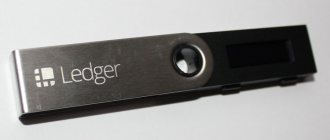Since the advent of Bitcoin, there have been many cases where the owner of the cryptocurrency lost access to the hard drive, and tens of thousands of BTC were lost forever. Other facts of loss are related to security problems - exchanges and wallets are hacked by hackers.
To solve these problems, so-called hardware wallets were invented to reduce the risk of hacking and accidental losses. One of the first such devices was developed by the French startup Ledger, created in 2014.
The company currently produces three types of Ledger hardware wallets – Ledger Nano S, Ledger Nano X and Ledger Blue. Today we will look at all the pros and cons of these devices, tell you how and where to buy them, and compare them with their competitors.
- Ledger Wallets
- Benefits of Ledger Wallets
- Setting up Ledger Nano S
- How and where to buy Ledger
- Competitors to the Ledger wallet
- Is Ledger worth buying?
What is a hardware wallet
Let's start with the theory. A hardware wallet is one of the safest ways to store cryptocurrencies. Usually, in appearance it resembles a flash drive, and the similarity is not accidental. It really plays the role of an information carrier, but instead of films and documents, it stores something more important. Private keys.
Private keys are your document for using cryptocurrency. In practice, they are a code of numbers and letters that signs transactions. Simply put, it is the private key that allows a person to dispose of coins at his discretion. If he has the private key, he is the king. And if not, then most likely he is a client of an exchange or online wallet with some numbers in the balance line.
Ledger reached me from France
Hardware wallets store private keys internally and do not show them to anyone. If it is possible to hack an account on an exchange - and this happened to my colleague Valentin - then such an option is excluded here. This is the ideal option for storing coins and is what I recommend.
Why do you need a hardware wallet and familiarization with Ledger products
The topic of cryptocurrencies is at a high peak of popularity, despite significant fluctuations in the exchange rate. Unfortunately, it attracts not only investors and people who want to make money, but also scammers. On exchangers and exchanges, the keys to your wallet are on the service, but physical devices are more reliable, since the code from them is only in your hands.
This is why digital coin storage is divided into “hot” and “cold”. The first are a specific address with which you can operate your funds at any time and from anywhere.
Cold wallets are offline storage using USB drives or hardware devices. A hardware wallet uses a private key to sign a transaction, and when connected to the Internet, it still remains accessible only to its owner.
No hot wallet will provide the same level of secure storage as a cold wallet.
Ledger devices are produced by the French company of the same name, a leader in the production of hardware storage for cryptocurrency. Its first product, the multi-currency wallet Ledger Wallet Nano S, was released in 2014 and is a compact and easy-to-use flash drive. Later, the manufacturer’s second model appeared - Ledger Blue.
Which hardware wallet did you choose?
For myself, I chose the classic Ledger Nano S. I didn’t even consider other manufacturers. It's not because of their shortcomings: Ledger just has a reputation. And also a cool pink color that I liked. Pink is beautiful.
The only possible alternative was the Ledger Nano X, but I did not choose it. Firstly, the price difference is almost double. Secondly, the presence of bluetooth and a large screen was unimportant for me. This is still my first wallet, and who should I show the big screen to - my neighbors? No, Ledger should lie in a quiet place and should not be known about. In addition, the difference can be spent on buying BTC.
Ledger in pink
In general, now my coins are kept safe, and I wish the same for you. Now I’ll tell you three stories that led me to this.
How to use your Ledger Blue device
The package is standard: in addition to the device itself, it includes instructions, a USB connecting cable, a form for saving the seed phrase, and a fabric bag for transportation. The battery in it is rechargeable, 500 mAh.
You need to start working with the device with the following steps:
- Connect to PC using a cable;
- Charge if necessary;
- Press the “Power” button for 3 seconds and wait until the welcome window lights up;
- Select “Configure As New Device” (new configuration);
- Come up with a pin code similar to the Nano S model;
- Generate a 24-word control phrase.
According to the factory settings, the wallet supports Bitcoin and altcoins: Zcash, Ripple, Litecoin, Ethereum, Dogecoin. To add programs for other types of digital coins, you need to download the Ledger Manager add-on.
According to the memory parameters, you can install no more than 10 applications at the same time.
To conduct transactions with cryptocurrency, the device must be connected to a PC, then go to the tab with the “SEND” and “RECEIVE” arrows. Using the “Up” and “Down” buttons, select the application with the desired currency and start the installation procedure. Making transactions on this device is very simple:
- Activate the selected application;
- Indicate the recipient's wallet number and amount;
- Confirm the transaction.
By the way, if there is a need to install a wallet that you do not yet have in the device’s memory, and there is no longer room for it, feel free to delete the unnecessary one. This is a temporary measure: your coins on it will not go anywhere, you can return it to its place at any time.
How to lose cryptocurrencies. Option one
Remember at the beginning of the article I talked about a friend who persuaded me to buy bitcoins? We actually bought it, and at a very attractive rate. If I'm not mistaken, it was 3 thousand dollars per BTC. The scheme is simple: they deposited money on a common bank card, dealt with Localbitcoins and received the coveted numbers in the balance line.
And then the bull run began. Our eyes, people without much knowledge in the industry, lit up. After short negotiations, a few months later we decided to exchange part of the investment for altcoins.
Those were great times. We felt like real investors, although we were essentially choosing random cryptocurrencies based on the beauty of their name and the steepness of their growth in recent weeks.
— Watch how Ethereum grows. Surely it will grow more, right? Let's take it!
In general, more than half of the initial amount went into other coins. What to do next is unknown. I added all balances to my Delta portfolio, regularly updated rates and mentally divided the profit by two. Half for me, half for a friend.
Buying cryptocurrency
Guess what happened next? That's right, we successfully missed the bullrun.
I still remember the moment of the sharp collapse of the Ethereum price in January 2018. Then I was driving in the car in the passenger seat and for the first time I regretted getting involved with this topic.
But the trick is that in the end I had zero left from all the investments. Not a thousand, not a hundred, but precisely zero. How so? A friend left our coins on the exchange; there were some problems with access. As a result, in order to receive coins, I had to write to technical support, but it didn’t come to that. My friend simply disappeared from my life. Communication suddenly stopped, I still don’t know the reasons. Obviously, those coins end up on a blocked exchange account. By the way, I don’t even remember which one.
This is me when a friend left in 404
Conclusion: if I had kept coins on the ledger back then, I would now have a cooler portfolio. In addition, the profitability figures would be more pleasant. Still, that Bitcoin at 3 thousand is still cheaper than today’s 4,752 bucks.
About the safety of using a cryptocurrency device
The security of the gadget is one of the highest in this segment, although the previous version, according to the analytics of one of the leading rating agencies, for some reason scored 50 out of 100 possible points.
In the design of the crypto wallet you can see that there are only 2 working buttons and a visual display.
The developers consider this sufficient for authentication and reliable protection of the hardware device, and the gadget can be used bypassing the computer without fear of phishing.
But there are some important points about the operating safety of the device:
- If you enter your PIN incorrectly three times, all device data is deleted. It is not possible to restore your wallet using traditional methods. In order to, as a last resort, restore the device’s database, you will need to enter an additional mnemonic phrase.
- The mnemonic phrase itself looks like a regular set of 24 words. Literal values are generated only in the device (in earlier versions, generation took place in the software, so the developers moved away from this idea completely). Entering a mnemonic phrase will require entering all 24 encrypted words. And for a more reliable option, the developers simplified the recovery procedure by implementing the idea of entering a phrase based on the first 3-4 letter values.
- All encrypted data is stored inside the working case of the device, in particular in the latest models such as ST31H320. But much of the source code is publicly available on GitHub. In the future, it is planned to reveal information about the code step by step, but the hidden part will remain only in the software of partners that are related to the functioning of the hardware device.
According to the developers, integration with wallets such as Mycelium and Electrum is possible in the future.
go
How to lose cryptocurrencies. Option two
After that incident, I started buying coins on my own. Still, I got burned, became smarter and began to trust only myself. But have I become smarter about storing cryptocurrencies? Of course not.
Where else to store your savings, if not on the super-reliable Cryptopia?
It was no coincidence that I chose Cryptopia. At one time, I experimented with masternodes and even wrote about my experience in a separate article. In general, I wandered there to buy a DeviantCoin coin - remember this one? But in the end, for some reason, a small part of bitcoins was added to the exchange.
Cryptopia interface
Everyone knows what happened next. Cryptopia was hacked and then decided to be liquidated. More than a year has passed since then, but I still haven’t seen my cryptocurrencies.
But maybe I’ll see you in a year or two?
Conclusion: if I had already held crypto on the ledger back then, such stupid questions would not have arisen.
Ledger Blue Crypto Wallet - Full Review
This is also a cold wallet, released in 2016, but it looks a little different (like an MP3 player) and has a touch screen. The portable storage looks presentable, the body is made of plastic and stainless steel, the display glass is ultra-resistant, 3.5 inches thick, resolution: 320x480.
Device parameters: 97 x 68 x 10 mm, weight 90 g. The power button is located on the right, and at the bottom there is a micro-USB.
The cost of this model is €229.
Ledger Blue integrates the manufacturer's Ledger OS, which runs on Bolos (Blockchain Open Ledger) with open source code.
Advantages of this model:
- Support for more than 10 types of cryptocurrencies;
- Enhanced protection mechanisms;
- Availability of an antivirus program;
- Anonymity;
- Ease of use thanks to LCD touchscreen;
- Multi-OS support;
- Connection to PC and smartphones via USB, NFC and BLE;
- QWERTY keyboard support for input.
The disadvantage is that the device is connected via the Bluetooth wireless interface, but the developers promise to fix this error. Isolation from third-party interference is ensured by code protection from reading - the STM31 algorithm and a microcontroller that protects against copying - STM32.
How do you lose bitcoins? Option three
A year ago I was in Barcelona. The city is beautiful, sunny - but not all locals like tourists there. The two guys on the subway were just like that. The guys worked in pairs, although they acted from different sides. One pretended to be drunk, approached me and, as if by chance, scattered change and keys in front of me. While he was picking them up, he turned his back to me and slammed his back into me quite hard.
The push was planned: it was at that moment that his partner pulled out my phone from the inside pocket of my denim jacket. Yes, it was unzipped, but he actually pulled it from the inside pocket.
Brave Spaniard with my phone
I noticed it was missing right away. Fortunately, I was not on my own - but the guys didn’t know that. So after thirty seconds of me panicking and tugging at the thief’s sleeve, they decided to return my iPhone. The second guy pretended to pick him up from the floor. The phone ended up in my hands, and the guys got off at the nearest stop.
When I picked up the phone, I couldn’t believe my eyes. But the fingerprint unlocked the iPhone, so it really was mine. There was no limit to the joy.
And then it got scary. But not only because of the possible prospect of unplanned purchase of a smartphone in another country. Still, the iPhone contains the excellent Google Authenticator application, which allows me to access cryptocurrency exchanges, services and other important platforms. Obviously, the password backup codes are written down somewhere, but what if I ended up being unable to regain access to the exchange? Then I would have been faced with a repeat of the Cryptopia scenario.
No thanks. I don't want to anymore.
Conclusion: Ledger would have helped here too. There, an Authenticator is not needed to log in - a regular password is enough.
General Basic Characteristics
According to the control instructions, general technical data are presented:
- The overall part of the device is 98*18*9 mm;
- Device weight – 16 grams;
- The basic parameters of the connector are USB type Micro-B;
- Certification classifier - CC EAL5+;
- Security chips - ST31H320;
- The standard chip is STM32F042.
- Operating compatibility - Windows (7+), Mac (10.8+), Linux or Chrome OS.
- Additional requirements - you must provide access to Google Chrome or Chromium services, as well as one type of USB channel intended for connecting a hardware device.
- Material: plastic combined with stainless steel.
Review of Ledger Nano S
Fortunately, all this is left behind. Now my coins are not stored with friends, on exchanges and other vulnerable places. The ledger is in the right place, the seed phrase for restoring access is in an even more correct place.
By the way, losing Ledger is also not scary, because it is password protected. But you need to be careful with the seed phrase - after all, this is universal access to coins. If it falls into too smart hands, the coins will disappear from the wallet. So I recommend writing them down on some separate piece of paper (at least without the Ledger logo on it, as is included in the kit).
Advanced users also recommend encrypting the seed in the form of a poem or story. But this is also risky - you may not be able to decipher the encryption back. Over time, such things are forgotten. The same goes for passwords.
Ledger Pack Contents
I'm really pleased with the device. After the first launch, you need to go to the company’s start page and configure everything. Hints are everywhere, you won't get confused. Everything takes about twenty minutes, most of which will be spent on verifying the seed phrase.
The wallet wants to make sure that you have written down the phrase so that if something happens, you can restore access to the coins. So Ledger will check every word of the 24.
Ledger Applications
The mobile version of the crypto hardware wallet, Ledger Authenticator, is suitable for iOS and Android. You can download it on the official website.
With this program you can make transfers, control your account and transaction history. You can sync the app with your phone to receive notifications about every transaction, providing an additional layer of protection for your funds.
You can also download a unique organizer called Ledger Manager. When the program is installed, you will have access to a choice of Ledger Wallets, but no more than 5, based on the size of the device’s memory. But if you operate with several types of digital coins, the best option is the multi-currency Ledger Wallet Bitcoin.
To send any cryptocurrency to the desired address, you must do the following:
- Go to the SEND tab;
- Enter the address or scan the QR code with Ledger Wallet;
- We indicate the amount, check the commission (or select its size using the Transaction Fees option);
- We confirm the transaction with the right button of the device.
If you wish, you can also install an extension for the Chrome browser, where addresses for Bitcoin transactions will be generated. There you can change your account settings at your discretion.
Access DeFi from the Ledger Live app
Cryptocurrency hardware wallet company Ledger has announced that its users can now interact with DeFi protocols directly from the LedgerLive mobile app.
To reduce reliance on wallets such as Ethereum wallet MetaMask and MyEtherWallet, the Paris-based hardware wallet company has integrated the open-source WalletConnect protocol, which connects crypto wallets to decentralized applications.
This means Ledger customers will be able to access the open-source WalletConnect protocol directly from the company's mobile app and will be able to interact with DeFi protocols from cold storage.
Decentralized exchanges such as Uniswap and 1inch, marketplaces such as OpenSea and Rarible, and portfolio managers Totle and Zapper are among the dApps supported. Decentralized lending protocols including Aave and Compound are also supported.











